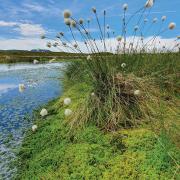Walk the entirety of the King Charles III England Coastal Path, and you’ll hike a weary 2,700 miles – that’s roughly the length of Chile, the Mekong River, or the legendary Cannonball Run from New York to Los Angeles.
Unfortunately – or perhaps, fortunately, depending on how fit you are – you can’t actually walk the whole length of the path just yet. The route, formerly known simply as the England Coast Path, but wreathed with the regal moniker a year ago to celebrate the Coronation of the new King, isn’t fully open. When it is, it will be the longest managed coastal path in the world, and will go round the entire English coastline, unlocking some parts of the coast to the public for the first time (you’ll have to make alternative travel arrangements to traverse Wales).
The plan is that the completion date – originally slated for 2020 but stymied, as were so many things, by Covid – will be later this year, possibly early next.

But the section that concerns us – from Filey Brigg to Newport Bridge in Middlesbrough, so taking in the entire North Yorkshire coast, and beyond – is already open for business.
Tackle those rather more manageable 68 miles – the longest stretch of the path to be opened so far – and you’ll come across some of the most breathtakingly beautiful coastal scenery to be found anywhere in the world.
Glorious Filey, with its seemingly endless sweep of sandy beach, is the starting point. Seven miles north, and you’ll head through Scarborough, Britain’s first seaside resort, with its towering castle. The Coastal Path follows the route of the Cleveland Way here, so you’ll head past SEA LIFE Scarborough with its distinctive pyramids, and up onto the cliffs.
If you’ve time, take a break at Ravenscar, some 10 miles up the coast – you’ll have the opportunity to find out about one of our most fascinating pieces of industrial heritage, the alum works, or stop off at the old railway station and find about the seaside resort that never was.
The next significant stop is Robin Hood’s Bay, one of the country’s most beloved seaside villages and riddled with tunnels and passageways that made it a major smuggling centre in the 18th and early 19th centuries.

Then it’s a clear run to Whitby, passing by the Whitby High Lighthouse before reaching the town itself in all its gothic glory. It’s an easy stroll from Whitby to tranquil Sandsend, the perfect place for a break for something to eat with unbeatable views.
The walk is getting a little more on the wild side now, as the cliffs to the north of the country start to rise. But there are still plenty of pockets of civilisation to explore before you reach the next town, Saltburn-by-the-Sea. Staithes is a must-stop – its beauty has attracted artists for years (you may have read more about that in the last issue of Yorkshire Life), and it’s packed with great places to eat.

Beyond Staithes, you’ll scale the cliffs at Boulby, home to several superlatives: it boasts the highest cliff on the eastern coast of England – a devilish 666 feet high. And look out for Boulby Potash mine, the deepest mine in Europe and home to the Boulby Underground Laboratory, the only deep underground science facility in the UK and a leading player in the hunt for dark matter.
From there, head to Saltburn-by-the-Sea and its spectacular pier – we suggest you treat yourself to an ice cream, you deserve it!
For more on the King Charles III England Coastal Path: nationaltrail.co.uk/england-coast-path
And for further information on what else is on across the Yorkshire Coast and the North York Moors National Park this month: discoveryorkshirecoast.com

Fancy mixing things up a bit? If you’re one of those people who likes a bit of countryside before their coast (or, as we like to think of it, you believe in saving the best till last), there are several famous walks that start inland and will keep you going with the promise of stunning North Yorkshire coastal views at the end.
The Cleveland Way: much of this 109-mile-long walk – which celebrates its 55th birthday on the 24th of this month – overlaps with the King Charles III Coastal Path. But if you start in Helmsley, you’ll head first across the stunning moorland landscapes of the National Park, taking in various landmarks associated with the area’s most famous son, Captain Cook, along the way. Finally, you’ll head through Saltburn Woods and emerge to be greeted by the gorgeous views across Saltburn-by-the-Sea with its sweeping bay and charming Victorian pleasure pier.
The Coast to Coast Walk: one of the UK’s most famous walks, designed by the much-loved fellwalker Alfred Wainwright, this 195-mile walk starts on the West coast in St Bees in Cumbria and ends a week, or maybe two, later on the East coast in Robin Hood’s Bay, where tradition dictates that weary walkers wet their boots in the North Sea before celebrating with a pint (or two, more likely) in the Bay Hotel.
The Lyke Wake Walk: a walk like no other, this 42-mile hike across some of the most remote parts of the North York Moors National Park follows the paths of old coffin routes on the moors – hence the coffin-shaped badge which those completing it in under 24 hours (yes, that means walking through the night!) are entitled to wear. Starting in Osmotherley, near Northallerton, it ends in the bar (where else?) at the dramatic clifftop Raven Hall Hotel in Ravenscar. Founded in 1955 by North Yorkshire farmer and local historian Bill Cowley, this epic challenge will be 70 years old next year.
Take care: if you’re planning to tackle any of these walks, do take care, not only of your own safety (suitable clothing, navigational aids, etc, go without saying), but of the countryside and wildlife. Many of these walks coincide at various points, which can concentrate environmental damage. Keep to the waymarked paths, don’t drop litter, keep your dog under control – as a Yorkshire Life reader, we’re going to assume you’re a reasonable and responsible human being, and we need say no more!



























